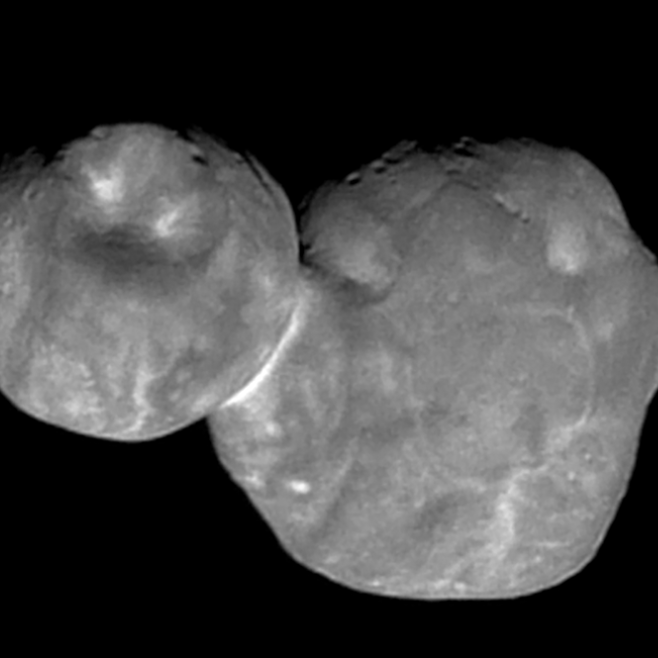
In 2014 the New Horizons science team discovered an object beyond Pluto that the New Horizons spacecraft could also visit after the Pluto flyby. The Minor Planet Center of the International Astronomical Union gave this object the provisional designation of 2014 MU69. The New Horizons team later nicknamed it “Ultima Thule.” It was discovered within the dense background star field of the Milky Way Galaxy and was very faint, making it difficult to see even in images from the largest ground-based telescopes. In fact, it was discovered not with a ground-based telescope, but with the Hubble Space Telescope.
We could measure how bright the object appeared in the Hubble images and, from measurements of its positions over time—relative to background stars—we could determine its orbit. An orbit is a set of six numbers which define the shape and orientation of the elliptical orbit that the object follows as it goes around the Sun. From those six numbers astronomers could determine an ephemeris, which allows us to calculate where the object would be in the sky at any time and also its distance from the Sun and Earth at that time. The orbit and resulting ephemeris allowed scientists to determine that this was an object that New Horizons had enough fuel to reach and that it could fly by the object around Jan 1, 2019. But, NASA still had a problem. If you know how bright an object appears from Earth (i.e., in the Hubble images) and you know how far away it is (from the ephemeris), then the object itself can be a very bright small object, or a dark big object. Both will reflect the same amount of light.
NASA needed to start planning for the flyby and, to do that, they needed to know if they would be looking at a bright object or a dark object to set the camera exposure times. But to determine if the object is intrinsically bright or dark, one needs to know the size of the object. You could make a reasonable guess for the brightness and derive a size (which was 10-15 miles across), but NASA needed to know the actual size and thus the actual brightness. So how does one measure the size of a 10-15-mile-diameter object which was (derived from the ephemeris) 4.2 billion miles away? You can’t just take a picture of the object and measure its size. Something this small and far away appears as just a point of light in even the biggest telescopes. In this case, we have to use a different technique – occultations. The word occultation comes from the verb “to occult” which means “cut off from view by interposing something.”
How does the occultation process work? Think of every star as a light source. Then every object in the solar system casts a shadow in the light of every star. These shadows move around as the solar system object moves in its orbit around the Sun. Each shadow is exactly the size of the cross-section of the object and occasionally a shadow may pass across Earth.
If you happen to be in a location where the shadow passes over you, then you would see the star disappear behind the object and, sometime later, reappear on the other side. We thus say that the star was occulted by the object.
Assume for a moment that the object is a sphere and its shadow is circular. If an observer is near the top or the bottom of the shadow, he or she will see a shorter disappearance than an observer who is near the middle of the shadow. We can convert an observed disappearance duration to a length since the object’s ephemeris tells us how fast the shadow is moving and distance = speed x time. If we have several observers in the shadow, we can reconstruct the size of the shadow. But the shadow is a cross-section of the object, so by measuring the size of the shadow, we measure the size of the object. Thus, this could be a way of measuring the size of MU69 if (and this is a big if) we knew in advance where a shadow of this particular object (cast by some star) would happen to pass across Earth and if (another big if) we could station several observers in the right place at the right time.
Let’s look at the first “if” first. How can we know, in advance, where and when, and from what star a shadow of MU69 will pass over Earth? To do this, we need the sky positions of lots of stars. Fortunately the European Space Agency recently launched a satellite called GAIA to measure the location of about a billion stars extremely precisely (the extremely precise aspect is important as we will see soon). And we have a precise ephemeris for MU69 as measured from Hubble images. It’s not quite as precise as the GAIA star positions (again, this will become important soon) but still extremely good. Given the ephemeris and star positions, I have a computer program which will compare the future ephemeris of a moving object against the GAIA star positions. It first searches for any stars that come close to the object’s projected ephemeris. For those stars, the program computes if the shadow of each star will cross Earth and if so, generates the “ground track” which is swept out as the shadow passes across Earth. To observe the occultation, we need to position observers somewhere inside the ground track. But not all ground tracks are usable—some go only over water; some only cover the part of Earth which is in daylight; some go places where it might be unwise to send observers (e.g. Congo, Iraq, Afghanistan). I ran my prediction program for 2017 and found three possible occultations (Figure 1).

Figure 1
The next problem (the second big if) is how do you get enough observers within this exceedingly narrow path to determine the size and shape of the shadow? To do this, the science team purchased 25 portable telescopes (Figure 2). Portable is a relative word here. The telescope comes in four crates which together weigh about 125 pounds and take two people to move. But the advantage is that the telescope can be run completely off the grid. The telescope and camera are powered by a battery normally used to boost a car and the camera is controlled by a laptop with its own battery. Thus, once the 100 crates that comprise the 25 telescopes are shipped in a container to some location near the track (by truck or by boat), each observing team can use a truck or SUV to set up a telescope within the track.
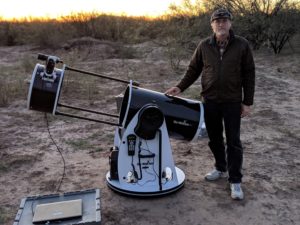
Figure 2
The reason for having many telescopes is that you need to set up a “picket fence” of observers across the track. To allow for uncertainties in the prediction, the picket fence needs to extend wider than the predicted track. How wide depends on how uncertain you estimate the ephemeris to be. The GAIA star positions are extremely good and do not add to the uncertainty; the primary uncertainty of where the track will actually be comes from uncertainty in the ephemeris. The hope is that while not everyone will be in the actual shadow, several observers will be. The trick is to spread the 25 telescopes far enough apart so that the uncertainty in the location of the track is covered without spreading the observers so far apart that, for example, only one observer is within the shadow. So, lines are drawn on a map parallel to the center of the track with each line separated by X miles such that the 25 lines define the picket fence. X is determined by the estimated size of the object and the estimated uncertainty in the object’s ephemeris. Each observing team has to find an observing spot on or close to (within perhaps a quarter mile) “their” assigned line.
The first occultation on June 3 went near Mendoza, Argentina and Cape Town, South Africa. As a hedge against bad weather, 12 stations went to Mendoza and 13 to Cape Town. I went to Mendoza. In Argentina, each team consisted of two astronomers and a local Spanish speaker. Each team had a truck to carry the equipment. We also had the cooperation of NASA, the Argentinian space agency, the local police, air force and coast guard. Note that the picket fence could be set up over the entire track so that the tracks assigned to the South African teams could properly interweave with those assigned to the Argentinian teams. The weather cooperated at the time of the event. Our results: nobody saw anything. It turned out that the uncertainty in the ephemeris was larger than we thought and the actual track was outside our picket fence.
The next occultation on July 10 was mostly over water. This time the event was tried by SOFIA, which is a 747 airplane with a telescope looking out from the side. I did not go on this one. It is difficult to put a 747 flying at 500 miles per hour into a 10-15 mile wide strip just in time for a shadow which is moving at 12 miles per second (43,000 miles per hour) to pass over you. This event was also a miss.
The final occultation on July 17 passed over Argentina near the town of Comodoro Rivadavia in Patagonia. This time we sent 24 telescopes (one was broken) and set up much like we did in Mendoza (two astronomers, one Spanish speaker, one truck per team) again with the cooperation of local police, government, etc. Between the time of the first occultation and this one, we had obtained more observations of MU69 with Hubble and felt we had a better handle on the ephemeris. Thus, we made the picket fence tighter than we did for the first event and placed the observers about three miles apart. This time everything worked and there were five observers in the shadow. I note that the entire occultation took only about one second!
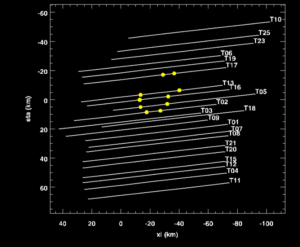
Figure 3
So what did we determine from the occultation? It’s easiest to see if we look at this a slightly different way. Rather than the star being fixed and the object moving, think of the object as being fixed and the star moving instead. In that case, we can plot the tracks of the star in the sky as seen from each observing site. Some of these tracks will cross the object, some will miss (see Figure 3). The T numbers are the numbers that were assigned to each team. Twenty-two of the teams successfully observed the event; 17 were misses and five saw the occultation.
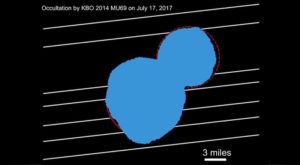
Figure 4
The disappearances and reappearances are marked by dots which outline the shape of MU69. It’s obvious from the figure that it has an odd shape. It’s definitely not a sphere. So what is it? It turns out that the shape can be fit by two spheres (see Figure 4), making it either a binary system (two objects orbiting each other) or a contact binary (two objects physically touching). Both of these types of objects are known to already exist in the solar system.
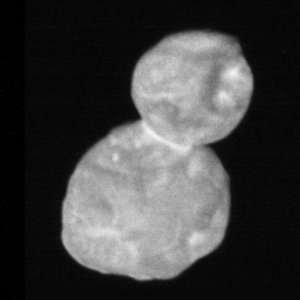
Figure 5
Once New Horizons actually got to MU69, it was clear that it is a contact binary and if we compare its profile on the occultation fit from Figure 4, we can see that the occultation result is an almost perfect match to the true profile (Figure 5). So—Mission Successful.